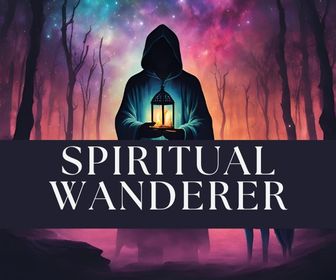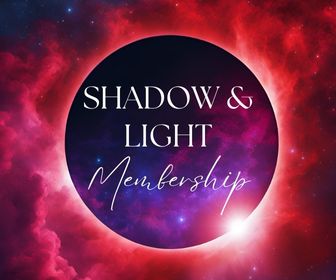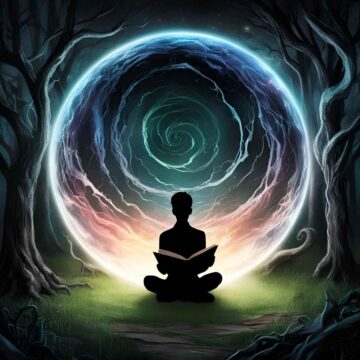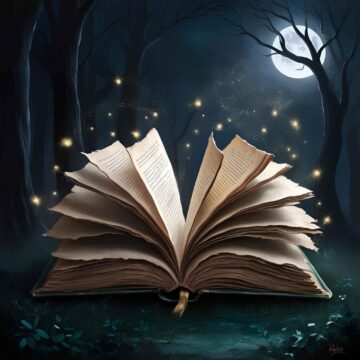What is Hypnagogia?
We all know that there are two primary states of consciousness: wakefulness and sleep. But did you that there is also an in-between state? This state is called Hypnagogia, a word that derives from the Greek words “hypnos” (sleep) and “agogos” (leading), meaning the state that leads into sleep.
Have you ever had a nap and experienced a strange trance-like state in which images, colors, sounds, even dream-like stories play out in your mind? Have you ever found yourself falling asleep and seeing a kaleidoscope of colors and shapes fleet in and out of your mind … or strange things like horses turning into helicopters? These experiences are hypnagogia in action and it’s likely that you experience hypnagogia multiple times a week, or even every day before you fall asleep!
So how can this unusual limbo state contribute to our self-understanding and spiritual growth? In this article, I’ll explain how.

Spiritual Wanderer Course:
Being a lone wolf and a spiritual wanderer is a sacred calling in life – a unique and alchemical path of awakening. You don’t need to feel lost, alone, or stuck on your journey any more. It’s time to meet your soul’s deep needs for clarity, self-acceptance, and empowerment. Let us show you how …
Table of contents
Types of Hypnagogia
Depending on whether you are primarily a visual (image-oriented), auditory (sound-oriented), or kinesthetic (physically-oriented) person (you can take a test here), your hypnogogic experience will vary.
Here are common ways hypnagogia is experienced:
- Images – e.g. monochromatic or colorful, static or moving, flat or three-dimensional – usually the images are fleeting but sometimes they form entire dream-like scenes
- Sounds – may be loud or quiet and involve hearing music, voices, snatches of conversation, rain, wind, white noise, repetitive words, having one’s name called, etc.
- Repetitive actions – known as the “Tetris effect,” when a person has spent a long time doing something repetitive (such as working, playing chess, exercising, reading) they may find themselves doing the same thing as they fall into the hypnagogic state
- Physical sensations – tastes, scents, textures, and sensations of coldness and heat may be experienced during hypnagogia, as well as feelings of floating, falling, leaving one’s body or having one’s body change shape
- Mental processes – at the edge of sleep thoughts begin to take a fluid and free-associative quality in which they morph and evolve in unusual, abstract, and innovative ways, uninfluenced by the ego
- Sleep paralysis – the temporary inability to move may, in some occurrences, accompany hypnagogia, however while this state may be alarming, it is harmless
It is also possible (and common) to experience multiple forms of hypnagogia. For example, you might visually enter a memory from the day that transforms before your eyes into an array of physical sensations and sounds. The combinations are limitless.
Spiritual Oneiromancy, Dali, and Dream Yoga

Throughout history, there have been many writers, artists, and philosophers who have used hypnagogia as a way of triggering new ideas, insights, and even inventions.
Artist Salvador Dali, writer Mary Shelley (author of Frankenstein), and inventor Thomas Edison are some of the most notable historical figures who have used hypnagogia to stimulate saucy new ideas. Both Dali and Edison, for example, used very similar techniques of sitting down with objects in their hands (a key for Dali and brass balls for Edison) and waking up once the object fell and hit the floor. This sudden awakening allowed them to quickly jolt out of their hypnagogic slumber and write down the thoughts and images that had been dancing through their minds.
In Tibetan Buddhism, hypnagogic states are used as a way of practicing “dream yoga.” Dream yoga is a form of spiritual practice that is based on the premise that dream-like states can be used to train the mind to enhance spiritual awareness. This self-discipline can contribute to the experience of enlightenment or self-realization.
In the modern age, there’s a niche of people who refer to themselves as Oneiromancers; or individuals who use dreams as a form of divination. The word Oneiromancy comes from the Greek ‘oneiros’ (dream) and ‘manteia’ (prophecy). Such people commonly use and interpret dreams as a way of prophesying the future.

Shadow & Light Membership:
⭐️⭐️⭐️⭐️⭐ "Shadow and Light’s weekly guidance always rings true to my heart. Thanks for acknowledging my shadows and inviting my inner light. I always get excited to open the Shadow and Light emails on Sunday!" – Angela M.
Even psychologists such as Carl Jung and Sigmund Freud have taken an intense interest in dreams and their potential meanings. Jung was notorious for his fascination with dreams and their connection with the unconscious mind since childhood.
I can’t personally vouch for the divination aspect of dreams (as in ‘oneiromancy,’ although I have had prophetic dreams). Furthermore, I believe that predicting the future is useless and a major distraction unless it is accompanied with work grounded in the present moment. That is why my approach to dreams and hypnagogia specifically is targeted towards psychological growth. Without understanding yourself, meeting your shadow self, uncovering and dealing with old traumas and wounds, and integrating what you find, you won’t get very far. All of the dream work in the world will be just that: a bunch of fantasy.
How to Use Hypnagogia to Explore Your Unconscious Mind
Hypnagogia is the shortest path for communication from our subconscious — Sirley Marques Bonham, physicist
In the secular world, hypnagogia is often used as a way of stimulating creativity. But I propose, similar to the Tibetan Buddhists and their ‘Dream Yoga’ and Carl Jung and his technique of ‘Active Imagination,’ that hypnagogia can be used for deep psychological discovery as well.
By seeking to find patterns, interpreting the images that arise, and coming in contact with the fragmented aspects of yourself, hypnagogia is a powerful form of self-exploration, and one with the potential of uniting you with your Soul’s Wholeness and ultimate purpose.
The unconscious mind is the part of our brain that contains everything we have buried away and forgotten: memories, defense mechanisms, wounds, ancestral traumas, archetypal forces or ‘sub-personalities’ – you name it.
In the trance-like state of hypnagogia we are able to observe our unconscious mind and its contents as it begins to bubble to the surface.
If you want to learn a simple and effective way of using hypnagogia to explore your unconscious, practice the one below:
1. Set an intention – ‘Prime’ your mind and get it ready before you go to sleep or have an afternoon nap. You can do this by constantly thinking about what it is you want to explore about 20-30 minutes before you go to rest. For example, your intention might be to find out why you struggle to have self-control around certain people, what mental belief is blocking your happiness, what your Shadow wants to tell you, or anything that is to do with you as a person. I find that it helps to be very clear about my intention and summarize it into a sentence. You can even write this sentence on a piece of paper if it helps. For example, your summarized intention might be “I want to understand why I always attract the wrong partners,” “I want to discover how to strengthen my social boundaries,” “I want to find out why I feel so unhappy and lost,” etc. Meditating on your intention is also a powerful way of priming your mind beforehand.
2. Find something to record your experience – Before you enter hypnagogia, find a notebook, journal, sketch pad, or voice activated recorder (there are mobile apps for that), and place it next to your bed/sofa/chair.
3. Set a gentle alarm – It takes on average about 10 to 20 minutes to fall asleep. So take a moment to consider how long it takes you on average to fall asleep. Do you go under quickly? In this case you might like to set the alarm on your phone or clock to 10 minutes. If you take a long time to fall asleep, experiment with setting your alarm to 20 minutes. With experience, and assessment of how tired you are beforehand, you’ll be able to skillfully adjust the alarm to the perfect amount of time that you need.
Would you like to save this?
Your information will never be shared.
4. Take a nap – Remember, your intention isn’t to fall asleep, (although if that happens, don’t worry, it can take practice!). Lie down on your bed, sofa, or whatever is comfortable, and relax. Let your body and mind drift off into a soft and hazy stupor. Completely unwind and let yourself be still.
5. Observe your mind – It is not always possible to clearly observe your mind, particularly when your consciousness is fading, which is why this step takes practice. You can use the sensation of your breath or chest rising and falling to help anchor yourself to awareness as you notice what is going on.
6. Time to record! – Bzzzz! At some point your alarm will go off. (Hopefully you set a gentle alarm, because loud obnoxious alarms can really be, well, alarming.) Once you’ve woken up, record what you have heard, seen, felt, or experienced. Do this quickly so that you don’t forget.
7. Interpretation – Reflect on what you have written, drawn or recorded. What are the first thoughts or feelings that pop into your mind? If you experience a strong physical/emotional ‘aha!’ reaction, you have found the right interpretation. Does your interpretation inspire, excite, or shock you? If so, it is probably correctly interpreted. According to Jungian analyst Robert A. Johnson, the best way to tell if you have interpreted dream imagery correctly is by the level of energy behind it. In other words, if your interpretation feels flat, dull, or lifeless, it is likely wrong. But if it feels alive and thrilling, you’ve likely found your answer.
Also, remember that hypnagogic imagery can be very abstract or very straight-forward – it is quite unpredictable. Sometimes it takes a while to interpret what you have experienced. Sometimes the material of your mind won’t be relevant to your question or intention. Keep practicing. Often images, words, sounds, and sensations may feel completely unrelated to your question. But when you revisit them a few days later, something may ‘click’ and you might suddenly discover how pertinent and symbolic they are.
8. Meditate on your discovery – After you have interpreted your hypnagogic content, sit and reflect on it. Meditate on its implications, lessons, and advice. I encourage you to journal about your experiences with hypnagogia as it will deepen your capacity to learn and grow from the practice. Learn more about how to journal.
***
Hypnagogia is a trippy, fascinating, kaleidoscopic world full of endless potential and possibility. Best of all, it provides an easy gateway to your unconscious mind. By taking advantage of this fleeting state of mind, you have the opportunity and ability to solve problems, gain guidance, and experience more inner peace and Wholeness.
Have you experimented with hypnagogic imagery before? Please share any tips or insights you have below!
Whenever you feel the call, there are 3 ways I can help you:
1. The Spiritual Wanderer Course: Need "big picture" direction, clarity, and focus? Our Spiritual Wanderer course is a crystallization of 10+ years of inner work, and it can help you find your deeper path and purpose in life as a spiritual wanderer. You get 3+ hours of audio-visual content, workbooks, meditations, a premium test, and more!.
2. Shadow & Light Membership: Want weekly intuitive guidance to support you on your awakening path? This affordable membership can help you to befriend your dark side, rediscover more self-love, and reclaim inner wholeness.
3. Spiritual Awakening Bundle: Looking for a collection of all our essential transformative resources? You get five enlightening ebooks, seven in-depth journals, plus two empowering bonuses to help you soul search, heal, and awaken.







I started having dreams as I was falling asleep and did not know what they were called till today when I read your article. I called them twilight dreams. They are very vivid and usually involve me having a conversation with someone. I also have vivid dreams that may repeat several nights in a row. Some have been so real when I am crying in the dream I wake up crying. Right now I am on medication to suppress the nightmares. But the dreams still come through and can be upsetting. I am going to try some techniques in this article and see if they help.
What could be missing or atrophied in us so in the beta state of the brain(state of alertness, logic and critical reasoning) we are not able to access the unconscious?
I have expirianced this state since I was young but last night was the most enlightening because I was aware of, and interacting with other people whom I know in real life.
I’m unsure if this was actual hypogognia, lucid dreaming (though I wasn’t actually asleep), astral projection or some odd combination, if that’s possible. Sounds played a huge part in the experience, one acpect of which was providing each pressance with a “sound signature” that I could use as navigational aids in way, if that makes sense.
I’m not sure if anyone else has actually interacted with multiple others before, at some points they were guiding me to things I needed to understand and sometimes I’d catch something out of the corner of my mind that I felt important and would take over navigation
The whole thing was surreal, enlightening and just profound. It also lasted well over 4 hours, during which I got up twice and was able to rejoin the goings on with ease.
This site has come into my life at time when I both needed and was ready to begin my journey. I love it
Never knew what it was called, but that’s my favorite state! Just enough ego (individuality) to be consciously aware, not so much as to be weighted down with all the concerns of life. Free to fly!
There’s a nice description of this in an old story by Nathaniel Hawthorne.
What a singular moment is the first one, when you have hardly begun to recollect yourself after starting from midnight slumber! By unclosing your eyes so suddenly, you seem to have surprised the personages of your dream in full convocation round your bed, and catch one broad glance at them before they can flit into obscurity. Or, to vary the metaphor, you find yourself, for a single instant, wide awake in that realm of illusions, whither sleep has been the passport, and behold its ghostly inhabitants and wondrous scenery, with a perception of their strangeness, such as you never attain while the dream is undisturbed. The distant sound of a church-clock is borne faintly on the wind. You question with yourself, half seriously, whether it has stolen to your waking ear from some gray tower, that stood within the precincts of your dream. While yet in suspense, another clock flings its heavy clang over the slumbering town, with so full and distinct a sound, and such a long murmur in the neighboring air, that you are certain it must proceed from the steeple at the nearest corner. You count the strokes—one—two, and there they cease, with a booming sound, like the gathering of a third stroke within the bell.
http://www.gutenberg.org/files/9209/9209-h/9209-h.htm
And sometimes they are scary as well, come to think of it, although it’s more like someone’s sending something to try and scare you, usually a twisted, though dark and not very clear face, as if from a horror film, which is pushed right in front of my face. But it’s really more a sensation than an image when that happens. I never feel scared and for some reason it always makes me feel quite confident and I smile at its attempt to scare failing, but I can imagine that it could be very scary. Why does that make me feel so comfortable, I need to think about that.
Unfortunately I have permanent and perpetual tinnitus. It’s almost inaudible most of the time but at night when it’s very quiet (like right now) the white noise from that in my left ear is very loud. So I don’t think I’ll have any auditory sensations, they’re always silent.
This sounds exactly like what I started experiencing in the last few weeks but with one major difference – it coincided with insomnia, which I’ve never had before, at least not to this extent. So while I’m lying in bed in the dark with my eyes closed, images appear, but only while I’m thinking. As soon as I stop thinking and pay attention to the image they disappear. And they’re never anything at all to do with what I’m thinking about.
To begin with they were very vivid and random, I really was worried I was going crazy, it’s like dreaming while awake. I’ve seen faces of people I’ve never met, buildings, landscapes, images as if from an action movie, a pink dragon with yellow dots(!), two Elizabethan men talking. I can’t remember most of them now because there have been so many, but I quite enjoy it. They’ve faded recently. They still appear, many of them, but as soon as I try to focus on them they’re gone, and they’re not so vivid, less colour and definition. But as soon as my mind wanders a new one appears and fades.
I’m so glad for this article as it sets my mind at rest and shows that I need to work out what they mean, if anything. I’ve never felt they mean anything yet, but they must mean something. I feel quite lucky because I don’t remember my dreams these days so I don’t think the above technique would work for me. But my insomnia seems to be allowing me to see them without even entering the hypagogic state. Or I am actually losing it lol.
As a long time meditator, I have developed my own system based upon specialised pranayama and chakra visualization techniques. This 20 minute practise routinely puts me into the hynogogic, transcendental state of deep parasympathetic nervous system functioning. I do it every day. I have not used it as a tool for targeted self exploration, but that is a good suggestion, must try it. I have done a lot of clearing work so perhaps this is not so important now as it would have been 10 years ago. To be able to access these mind states is a great gift, one that needs to be taught to rank and file. At some point I would like to teach my method as it is a powerful method for not just spiritual growth, but also as a health maintenance, anti-aging daily habit. Another great meditation that is easier to do is open-eye Ajna chakra meditation with a partner. This is such a good way for soul mates to connect, but also with other like-minded people. I did this in a Raja Yoga class in 1979 over several months and experienced open-eyes, awake visions and a 3-4 day ‘witness’ mind-state, fabulous.
Interesting to read this, thank you. I spent a lot of time alone until the age of about 6 because I lived with grandparents and there were almost no children around to play with. I reckon I spent a good amount of time in hypnagogic states and it was very interesting for me; although sometimes scary, I also found these experiences magical. The aspect of dominant senses is intriguing also. I can recall the morphing, body sensations outside of mundane logic, layered sounds. I struggled to frame these experiences in language or even thought and it left me with a kind of yearning feeling. About 10 or so years ago I learned this was Hypnagogia and felt most relieved that I wasn’t completely peculiar! I find this subject fascinating, but had never considered the possibility of using this state as a growth tool. Thanks again!
It’s curious how when we are younger we are so in tune with these things and as we get older we forget about them or devalue them by never thinking to use them again. I’ve been experimenting with it for a few years now and I’ve have very interesting experiences :) Good Luck!
Would craniosacral therapy bring one into the hypnagogic state? What I read above sounds a lot like what I experience during craniosacral therapy.
It’s quite possible. Most forms of bodywork put us into such deep trances thay we begin to drift into a hypnagogic state. I’ve had similar experiences with deep tissue massages.